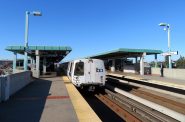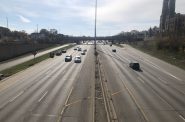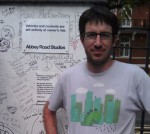The High Cost of Sprawl
All the city news you can use.
![Sprawl. Photo by David Shankbone (David Shankbone) [GFDL (http://www.gnu.org/copyleft/fdl.html) or CC-BY-SA-3.0 (http://creativecommons.org/licenses/by-sa/3.0/)], via Wikimedia Commons [ https://commons.wikimedia.org/wiki/File%3ASuburbia_by_David_Shankbone.jpg ]](https://urbanmilwaukee.com/wp-content/uploads/2017/10/1024px-Suburbia_by_David_Shankbone.jpg)
Sprawl. Photo by David Shankbone (David Shankbone) [GFDL (http://www.gnu.org/copyleft/fdl.html) or CC-BY-SA-3.0 (http://creativecommons.org/licenses/by-sa/3.0/)], via Wikimedia Commons
Your Sprawling Suburb Costs Money: Research shows that public services are less costly to provide where there is more compact development. In the average county area, per capita spending would increase by $5.26 if population density increased from the 25th to 50th percentile. However, decreasing the percentage of developed land from the 50th to 25th percentile would decrease per capita expenditures by $60.86. More compact and dense development can therefore pay dividends in lowering public expenditures. (Christopher Goodman | LSE US Centre)
MBTA ‘Rail Vision’ Comes Into Focus: ‘Rail Vision’ is an MBTA study for the future of greater Boston’s commuter rail. The study analyzed 6 alternatives, the simplest being merely adding new trains to the existing system, and the most ambitious being a $29B “full transformation” that would electrify the system, run trains every 15 minutes, and a build a new regional rail connection between North and South Stations. The analysis found that that electric trains, despite higher upfront costs, would carry significantly lower operational and maintenance costs. (Christian MilNeil | Streetsblog Mass)
Oligopolies Hold Back Affordable Housing: Economists estimate that dwindling competition in the homebuilding industry has cost the nation about 150,000 additional homes a year. From 2013 to 2017, home prices grew more than twice as fast as they would have if the market had not consolidated. Such creeping oligopolies are also symptoms of greater problems, like scarcity of land, cost of labor, restrictive zoning, and NIMBYism. Big real estate firms can hoard land for years and try to time the market, which further restricts new housing supply. (Andrew Van Dam | Washington Post)
The Future of the Bodega: Michael Silber, a Brooklyn-based designer and artist, runs a digital archive of New York’s bodegas; his photographs capture memorable features like red awnings and hand-lettered type on windows. But such elements are threatened by the Department of Small Business Services’ design guidelines, which essentially aim to make these unique businesses look more like chain stores, emulating competitors like Rite Aid and Whole Foods. Other organizations, like the Local Initiative Support Corporation, similarly aim to “support the revitalization” of communities, though residents argue that such efforts are erasing New York’s character. (Ethan Davison | Curbed NY)
Positive Results from London’s ULEZ: London City Hall published a report on the first six months of its Ultra-Low Emission Zone. Nitrogen oxide fell 31% since the introduction of the ULEZ earlier this year to reach a 45% reduction. The ULEZ has also resulted in 13,500 fewer polluting cars in central London each day. Traffic flow was also reported to have improved, encouraging people to switch to walking, cycling, or transit. Fine particulate matter, however, has only decreased marginally, though the report states that over 50% of London’s air pollutants blow in from outside sources. (Intelligent Transport)
Quote of the Week
The reality is the societal need for this technology and economic need for this technology is in cities, it’s not so much in suburbs.
-Zoox Co-Founder Jesse Levinson in Business Insider on where he believes self driving vehicles will be most useful.
This week on the podcast, we chat with Bay Area advocates Arielle Fleisher, Adina Levin, and Ian Griffiths about improved fare policy.
Want more links to read? Visit The Overhead Wire and signup. (http://dtrnsfr.us/2iA8Yas)
Urban Reads
-
Oakland Launches Universal Basic Mobility Program
 Jul 21st, 2024 by Jeff Wood
Jul 21st, 2024 by Jeff Wood
-
How Traffic Noise Impacts Children’s Brains
 Jul 1st, 2024 by Jeff Wood
Jul 1st, 2024 by Jeff Wood
-
Number of Super Commuters is Rising
 Jun 22nd, 2024 by Jeff Wood
Jun 22nd, 2024 by Jeff Wood




















